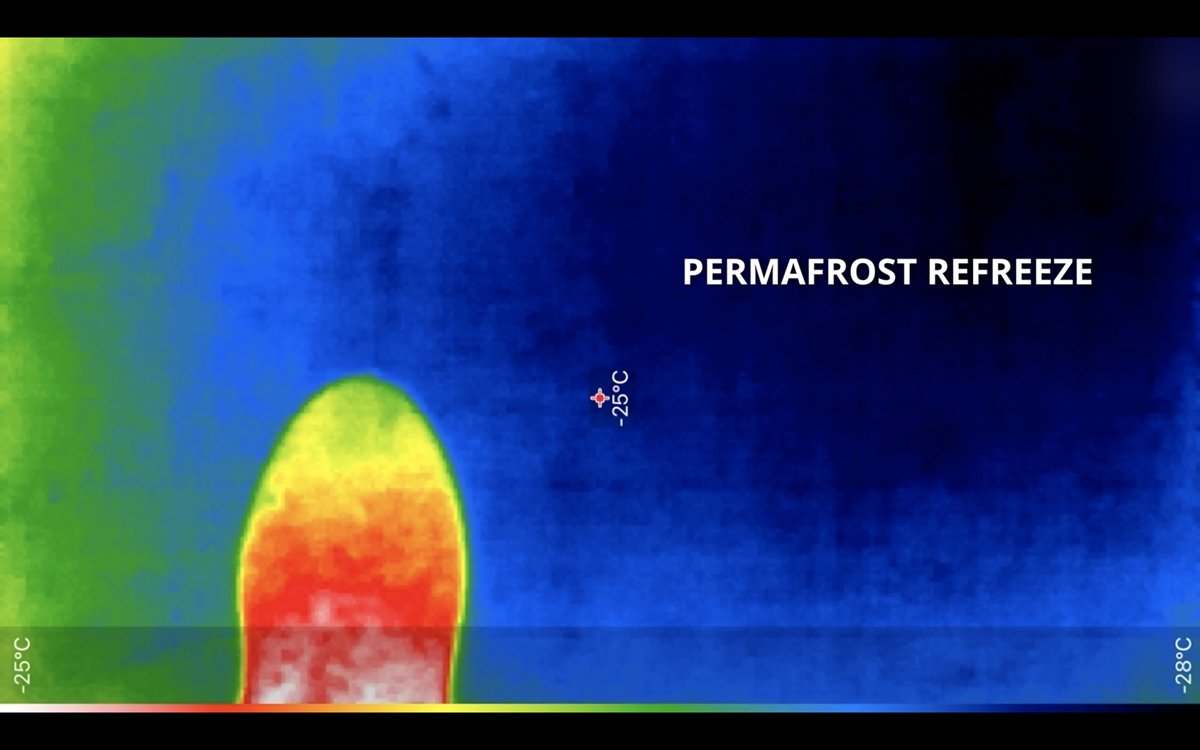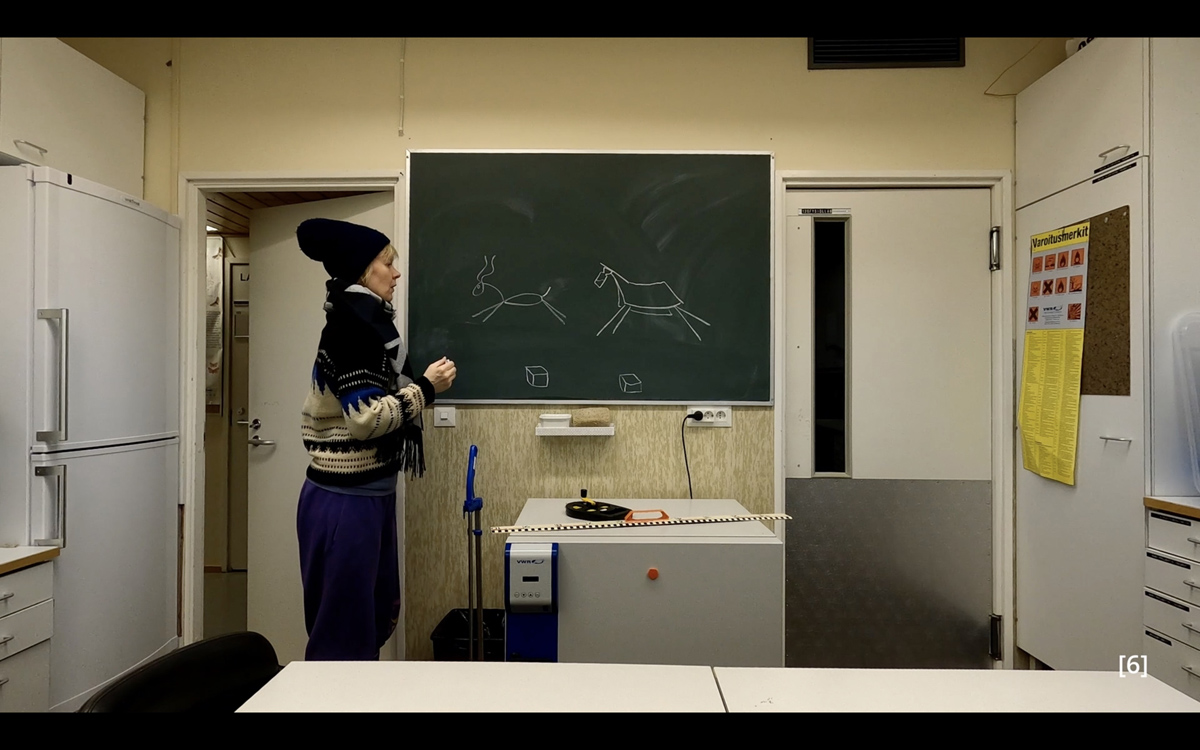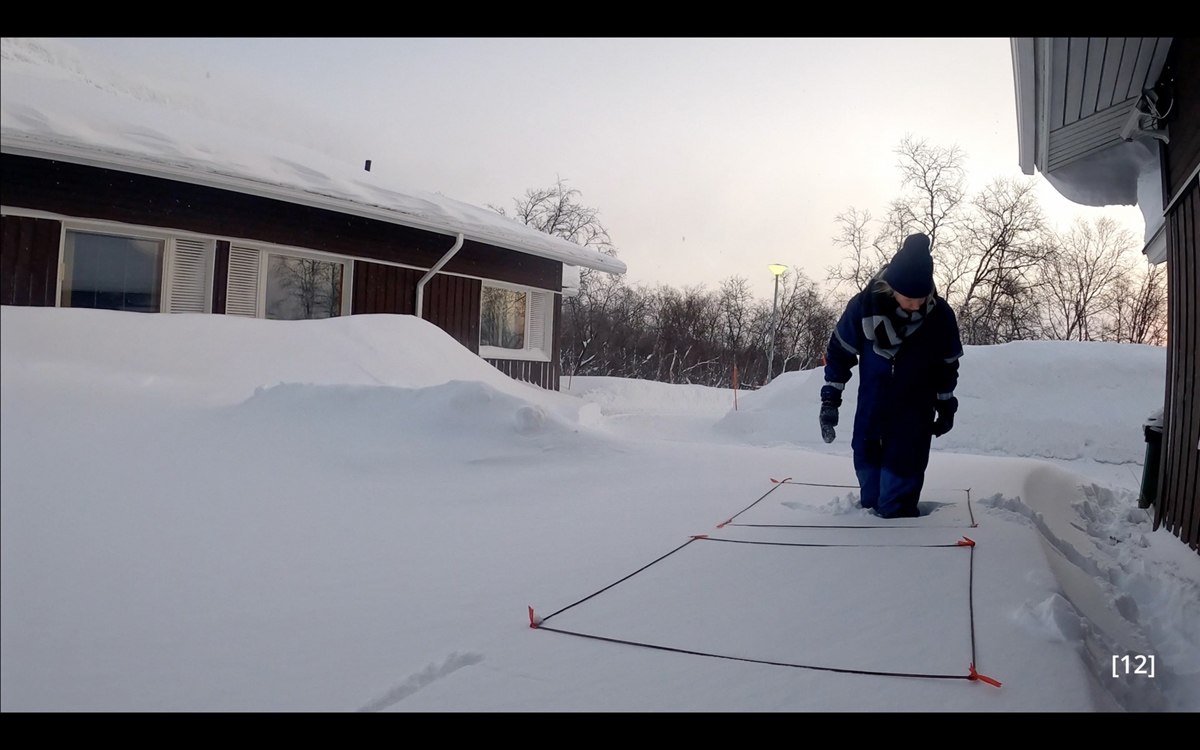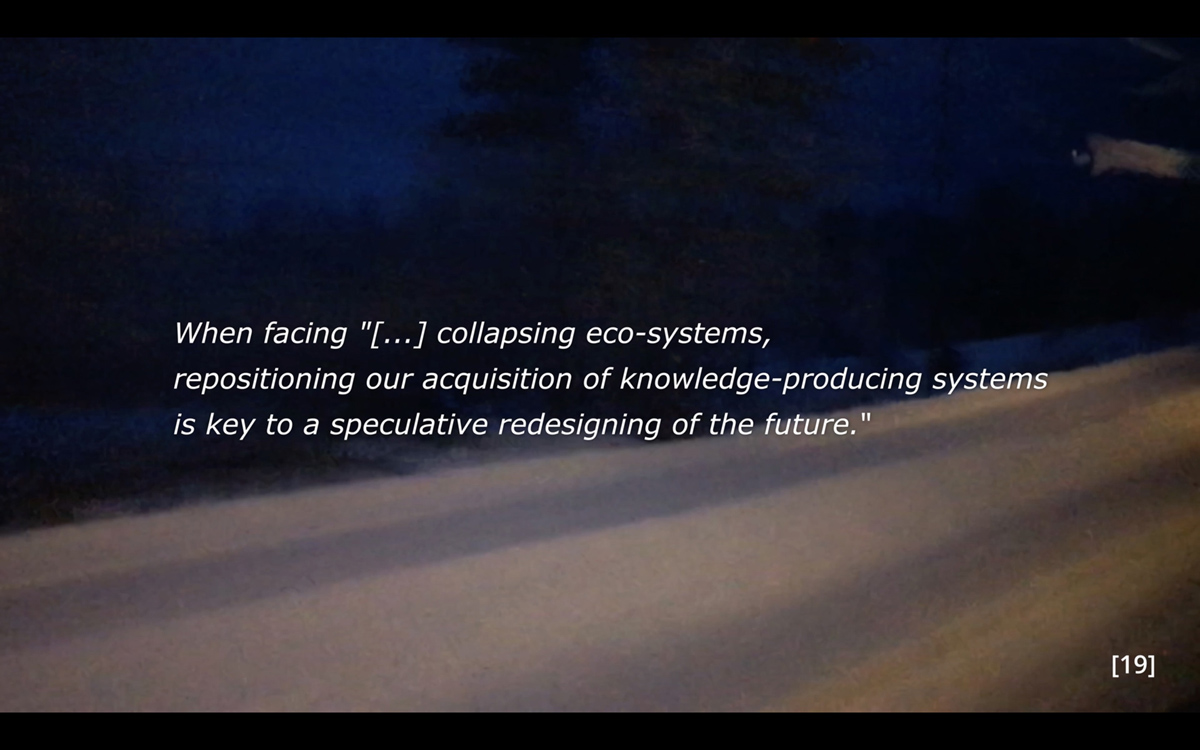VIDEO ARTICLE TRANSCRIPT
[Note: This is a transcript of a video article. Individual elements from the transcript, such as metadata and reference lists, may appear more than once in the document, in order to be properly read and accessed by automated systems. The transcript can be used as a placeholder or reference when it is not possible to embed the actual video, which can be found by following the DOI.]
PERMAFROST REFREEZE
THE REINDEER FACTOR
Abstract
Permafrost thaw plays a significant role in climate change, as global warming leads to massive amounts of organic carbon being released from the permafrost into the atmosphere. The article explores the so-called Zimov hypothesis, which involves non-human animals in mitigating permafrost thaw. According to the Zimov hypothesis, large herbivores such as reindeer and horse could prevent permafrost thaw as they compact the snow while grazing, keeping the ground temperature colder. Putting this hypothesis to test, the research introduces a speculative snow compacting experiment that utilizes the human body as a simulation for the reindeer body to measure the impact of snow stomping on the underlying ground temperature. Next to the impact of stomping, the preliminary results highlight the effect of rain on compacted snow.
Keywords:
permafrost, snow, reindeer, Zimov hypothesis, simulation, performance, bioart, rain-on-snow
[1:09]
INTRODUCTION
Kilpisjärvi, Finland. 69”N, 20”E. January 12, 2022. 11AM
Okay…
Permafrost covers over a quarter of the land area on the Earth as a ground that maintains a negative temperature for at least two consecutive years. [1] Instead of being a monolithic mass or a material thing, however, science considers permafrost a physical state. [2] Permafrost’s history is also fractious, consisting of political, social, and material dimensions, and the liminality between permafrost’s thaw and freeze affects the ways it is responded to. The meanings of frozen Earth have ranged from being an aggregate for concrete structures, a process and space tied to planetary exchanges of energy and matter, and an obstacle to construction. [3]
In this cross-disciplinary study, I am weaving together scientific permafrost research and performative bioart.
scientific permafrost research
performative bioart
new materialism
Bringing these to dialogue, I draw from new materialism, understanding permafrost and snow as intrinsically active and alive. [4] However, considering the materialities of ice and snow is not new. Arctic indigenous peoples have never neglected the matter or meanings of snow and now provide a valuable guide for science regarding shifts in nature and the categorization of different snow types. [5] Expanding from these viewpoints, my practice-based research develops performative-visual-experiential methods to explore the causes, conditions, and meanings of permafrost thaw mitigation.
It is generally acknowledged that Permafrost thaw is a direct consequence of global warming, and it will aggravate the climate crisis by releasing massive amounts of organic carbon into the atmosphere. [6] Less is known, however, about theories that consider non-human animals as ecological engineers assisting in a reversal of these adverse processes. I have travelled here to develop an experiment that explores the so-called Zimov hypothesis. [7]
*Zimov hypothesis
Zimov’s team has established a 2000-hectare experimental “Pleistocene Park” in Siberia to reverse the ecosystem shift which occurred ten thousand years ago [8] by megafaunal engineering at a scale not previously considered. [9]
*megafaunal engineering
According to this hypothesis, the increase in the number of large herbivores, such as reindeer and horses, in the Northern Latitude ecosystems will substantially decrease permafrost thaw as the herbivores compact the snow and thus keep the ground temperature colder. [7]
[4:47]
METHOD
I will explore three aspects of permafrost thaw mitigation involving megafaunal engineering: 1. Simulation of the reindeer with the human body. 2. Materialization of the Zimov hypothesis, and 3. Experimentation with previously unknown ways to utilize scientific thermometers.
1. Simulation of the reindeer with the human body
2. Materialization of the Zimov hypothesis
3. Experimentation with thermometers
The experiment measures the impact of snow stomping to the ground temperature by utilizing Thermochron temperature loggers under snow for four days.
The quadrats are here made into boundary objects, into a shared space, where the sense of here (the arts) and there (the science) is confounded. [10]
*boundary object
Art-materially speaking, snow is like an aquarelle. You can only paint it once. Or, you can wait for your mistakes to be covered.
The ‘nested’ methodology this study consists of methods within methods [11], all of which include an aspect of simulation.
*nested methodology
At the core, there are the actual performative and embodied methods, which partly look like ‘doing science.’ These are enveloped by the methods of documenting and representing the ‘doing of the science.’ Compositionally, there are the methods of structuring the study as a scientific paper.
Data logger method 1: Horizontal insertion
INTRODUCTION
METHOD
RESULTS
DISCUSSION
I could claim that this is a conscious commentary on science communication, and it is, but the research also ‘naturally’ fell into this structure. Years of reading science papers have changed how my brain processes information and consequently changed my art practice.
What is suggested here is that the human body can be utilized as a simulation of a reindeer body to test the impact of snow stomping in a controlled manner. The simulation relies quite literally on a “new materialization” of the reindeer body in my body, attempting to challenge the logic and biopolitical practice of human-animal binarism. [12] The study also introduces a new question to be solved by the Thermologgers, suggesting there are previously unknown problems to which the loggers could be applied. [13]
Body print test
Cooking pan test
Preliminary tests leading to this experiment included throwing my body into a snow drift and measuring the impact on temperature. I also inserted the loggers into cooking pans and compared the temperature differences between the snow compacted with a potato masher and a sieve. No significant differences came out of these less than 24-hour tests.
Data logger method 2: Vertical insertion
DAY 1
Surface pressure = force ÷ area
Even though my body weight is similar to a young reindeer, reindeer hooves and human feet are very different, and the surface pressure of the reindeer is much lower than my personal surface pressure. [14]
65 kg ÷ 0,17 m2 = 382 kPa
This would require more research and potentially a development of reindeer hoof shoes for a human subject to be worn in a simulated snow stomping experiment.
DAY 2
There is a fundamental question in natural sciences: What belongs in the quadrat. Or who belongs at it. Artists can be seen as alien species [15] disrupting the scientific rigor and illusion of objectivity.
DAY 4
I guess should have measured how long I was stomping per day. Sometimes I did it just for a short while, sometimes I got carried away if there was more snow. The experiment stems from my background in performing arts and moving image, and the art-science practice I’ve developed by collaborating with scientists and clinicians.
[onscreen timer running up to 01:41:20]
Instead of following a predetermined protocol or a script, the experiment emerges improvisationally as a durational performance. Each step arises from the first-person sensory perception of the dynamism of the site. My activity is thus less reminiscent of production and more of a relationship [16] with the site, snow, temperature, wind, light, and the camera. In fact, the camera is central in this process. I am observing the site, and myself, both in front of the camera and behind it. By selecting the camera frame and recording my performance, the study has an audience already at the field trip site even though I am alone.
Meanwhile, there are also views according to which reindeer do not belong to the quadrat in large quantities as trampling can damage plants and soil. [17] The Zimov hypothesis, however, suggests an increase of 200 million individual reindeer [7], which would need to be transported to the site or bought from local indigenous communities. Seen from the critical animal studies perspective, might there be species exploitation embedded in seeing reindeer solving the human-created climate crisis? And if so, can we afford to be bothered by it?
[12:06]
Two days later
RESULTS
I found the loggers after forty minutes of digging. Partly due to my kitchen grade instruments, partly because the day of –25 Celsius after rain-on-snow [18] had frozen the area rock solid.
*rain-on-snow
Okay… Okay… Results…
DAY 1 / –10°C
DAY 2 / –6°C
DAY 3 / +2°C rain-on-snow
DAY 4 / –6°C
There is data! It is just very different than expected. While my results initially confirmed the Zimov hypothesis by indicating a slightly lower temperature in the compacted area, the situation rapidly changed during and after the rain-on-snow day.
Control quadrat [chart]
Compacted quadrat [chart]
It’s difficult to stop the documentation and leave the field. Because something might just happen. Also, snowing is creating an illusion of recovery, a fallacy of recovery, as if the site returns to its original state.
[14:07]
DISCUSSION
A scientist asked me, in front of an audience, whether I am aware that in science, experiments are typically repeated. I tried to talk myself out of it by explaining that repetition is also an important aspect of artist’s training, when learning about a particular technique or choreography. I also clarified that the aim of my preliminary experiment was to expand the imagination of how the impacts of reindeer could be researched. I could have also said that, when facing “collapsing eco-systems, repositioning our acquisition of knowledge-producing systems is key to a speculative redesigning of the future.” [19]
When facing “[…] collapsing eco-systems, repositioning our acquisition of knowledge-producing systems is key to a speculative redesigning of the future.” [19]
Reflecting on how the results came about, I’m thinking the rain water simply got closer to the loggers on the compacted area. However, what does this mean in a grand scheme of things, now that Arctic rain-on-snow is becoming much more frequent and is linked to climate change? [18] Is rain one of the disruptive factors in the success of the Zimov hypothesis? When there’s rain on snow, and it will be stomped over, it is almost impenetrable, and not just almost; it will be impenetrable for the reindeer to find food, and even search for food. [20] So, there isn’t grazing around, there isn’t stomping around, so the whole hypothesis starts to fall apart, just because of rain. I think the lens of research is somehow protecting me emotionally from absorbing the meaning of the results and considering how abnormal it is that I managed to capture rain-on-snow during randomly chosen days, mid-January.
The study embraces tension and disruption in many ways.
*diffraction
Like diffraction, it intentionally troubles two solidified, if not frozen binaries [21]: art-science and human-animal. What’s more, the topic concerns the liminal state of permafrost and the method stages quadrat as a confusional boundary object. In these ambiguous borderlands, it is the “new normal” that an artist is studying arctic megafaunal ecological engineering.
The resulting science-based art could inform science as well. In general, it could be seen as an invitation to consider the potential of embodied simulation in cross-disciplinary climate crisis research. Hypothetically, the new models for herbivore simulation could lead to reducing the stress of animal transportation. The research also develops ways to represent field trip studies, highlighting the process of reality-making instead of the results only. Finally, to the very minimum, my practice is a gesture of care as one of the passengers who have a horse — and a reindeer — in this race, journeying toward our shared unknown future.
[18:13]
In loving memory of my brilliant friend Dr. Peter Lloyd Jones (1965–2022), with whom the research in the Arctic was conceived, and whose profound art-science commentary was invaluable to this video article.
All that we love deeply becomes part of us
Helen Keller
A video article by Kaisu Koski:
research, performance, camera, editing, voice-over.
The research has been conducted at the Ars BioArctica Residency at the Kilpisjärvi Biological Station, on traditional land of the Sápmi.
With the generous support of:
Laboratory technician Oula Kalttopää and the staff at the Biological Station
BioArt Society and the residency mentor Leena Valkeapää
Per-Henrik Tornensis and his Reindeer
Reindeer field work assistant Tea Ahjosaari
The research has been financially supported by Lab4Living and Research England.
2002
Sheffield Hallam University
Lab4Living
References:
1. Van Everdingen, R. (ed) (1998) Multi-language glossary of permafrost and related ground-ice terms. (revised May 2005) National Snow and Ice Center, Boulder, Colarado.
2. Dobinski, W. Permafrost, Earth-Science Reviews, Volume 108, Issues 3–4, 2011, Pages 158–169, https://doi.org/10.1016/j.earscirev.2011.06.007.
3. Chu, PY. The Life of Permafrost. A History of Frozen Earth in Russian and Soviet Science, Toronto: University of Toronto Press, 2021.
4. Gamble CN, Hanan JS & Nail T (2019) WHAT IS NEW MATERIALISM?, Angelaki, 24:6, 111–134, DOI: 10.1080/0969725X.2019.1684704.
5. Riseth, J., Tømmervik, H., Helander-Renvall, E., Labba, N., Johansson, C., Malnes, E., … Callaghan, T. (2011). Sámi traditional ecological knowledge as a guide to science: Snow, ice and reindeer pasture facing climate change. Polar Record, 47(3), 202–217. doi:10.1017/S0032247410000434.
6. Abbott BW, Brown M, Carey JC, Ernakovich J, Frederick JM, Guo L, Hugelius G, Lee RM, Loranty MM, Macdonald R, Mann PJ, Natali SM, Olefeldt D, Pearson P, Rec A, Robards M, Salmon VG, Sayedi SS, Schädel C, Schuur EAG, Shakil S, Shogren AJ, Strauss J, Tank SE, Thornton BF, Treharne R, Turetsky M, Voigt C, Wright N, Yang Y, Zarnetske JP, Zhang Q and Zolkos S (2022) We Must Stop Fossil Fuel Emissions to Protect Permafrost Ecosystems. Front. Environ. Sci. 10:889428. doi: 10.3389/fenvs.2022.889428.
7. Sneguirev, D. 2021. Back to the Ice Age – The Zimov Hypothesis. Arte France. [L’Hypothese Zimov – Le Film].
8. Beer C, Zimov N, Olofsson J, Porada P, Zimov S. Protection of Permafrost Soils from Thawing by Increasing Herbivore Density. Sci Rep. 2020 Mar 17;10(1):4170.
9. Macias-Fauria M, Jepson P, Zimov N, Malhi Y. 2020 Pleistocene Arctic megafaunal ecological engineering as a natural climate solution? Phil. Trans. R. Soc. B375:20190122.
10. Leigh Star S. This is Not a Boundary Object: Reflections on the Origin of a Concept. Science, Technology, & Human Values. 2010;35(5):601–617. doi:10.1177/0162243910377624.
11. Lotz-Sisitka, H. * and Raven, G. (2004) Learning through cases: adopting a nested approach to case-study work in the Gold Fields participatory course initiative, Environmental Education Research, 10:1, 67–87, DOI: 10.1080/1350462032000173715.
12. Jackson, Z. I. (2013). Animal: New Directions in the Theorization of Race and Posthumanism. Feminist Studies, 39(3), 669–685. https://doi.org/10.1353/FEM.2013.0024.
13. Westrum, R. Technologies & society: the shaping of people and things. Belmont, CA: Wadsworth Pub. Co. 1991.
14. Nieminen, M. (1990). Hoof and foot loads for reindeer (Rangifer tarandus). Rangifer, 10(3), 249–254. https://doi.org/10.7557/2.10.3.865.
15. Richardson, D. M., Pyšek, P., Rejmánek, M., Barbour, M. G., Panetta, F. D. & West, C. J. (2000). Naturalization and invasion of alien plants: concepts and definitions. Diversity and Distributions 6, 93–107.
16. Haapoja, T. 2020. How to Become Human? MaHKUscript: Journal of Fine Art Research, 4(1): 11, pp. 1–9. DOI: https://doi.org/10.5334/mjfar.83
17. Tuomi, M, Väisänen, M, Ylänne, H, et al. Stomping in silence: Conceptualizing trampling effects on soils in polar tundra. Funct Ecol. 2021; 35: 306– 317. https://doi.org/10.1111/1365-2435.13719.
18. Putkonen, J., and Roe, G. (2003), Rain-on-snow events impact soil temperatures and affect ungulate survival, Geophys. Res. Lett., 30, 1188, doi:10.1029/2002GL016326, 4.
19. Anker S. Epistemic practices in Bio Art. AI Soc. 2021 Feb 8:1–6. doi: 10.1007/s00146-021-01152-w.
20. Serreze, M.C. et al 2021 Environ. Res. Lett. 16 105009.
21. Barad, K. (2014) Diffracting Diffraction: Cutting Together-Apart, Parallax, 20:3, 168–187, DOI: 10.1080/13534645.2014.927623.
References
Van Everdingen, R. (ed) (1998) Multi-language glossary of permafrost and related ground-ice terms. (revised May 2005) National Snow and Ice Center, Boulder, Colarado.
Dobinski, W. Permafrost, Earth-Science Reviews, Volume 108, Issues 3–4, 2011, Pages 158–169. DOI: http://doi.org/10.1016/j.earscirev.2011.06.007
Chu, PY. The Life of Permafrost. A History of Frozen Earth in Russian and Soviet Science, Toronto: University of Toronto Press, 2021. DOI: http://doi.org/10.3138/9781487514242
Gamble CN, Hanan JS & Nail T (2019) WHAT IS NEW MATERIALISM?, Angelaki, 24:6, 111–134. DOI: http://doi.org/10.1080/0969725X.2019.1684704
Riseth, J., Tømmervik, H., Helander-Renvall, E., Labba, N., Johansson, C., Malnes, E., … Callaghan, T. (2011). Sámi traditional ecological knowledge as a guide to science: Snow, ice and reindeer pasture facing climate change. Polar Record, 47(3), 202–217. DOI: http://doi.org/10.1017/S0032247410000434
Abbott BW, Brown M, Carey JC, Ernakovich J, Frederick JM, Guo L, Hugelius G, Lee RM, Loranty MM, Macdonald R, Mann PJ, Natali SM, Olefeldt D, Pearson P, Rec A, Robards M, Salmon VG, Sayedi SS, Schädel C, Schuur EAG, Shakil S, Shogren AJ, Strauss J, Tank SE, Thornton BF, Treharne R, Turetsky M, Voigt C, Wright N, Yang Y, Zarnetske JP, Zhang Q, and Zolkos S (2022) We Must Stop Fossil Fuel Emissions to Protect Permafrost Ecosystems. Front. Environ. Sci. 10:889428. DOI: http://doi.org/10.3389/fenvs.2022.889428
Sneguirev, D. 2021. Back to the Ice Age – The Zimov Hypothesis. Arte France. [L’Hypothese Zimov – Le Film].
Beer C, Zimov N, Olofsson J, Porada P, Zimov S. Protection of Permafrost Soils from Thawing by Increasing Herbivore Density. Sci Rep. 2020 Mar 17; 10(1):4170. DOI: http://doi.org/10.1038/s41598-020-60938-y
Macias-Fauria M, Jepson P, Zimov N, Malhi Y. 2020 Pleistocene Arctic megafaunal ecological engineering as a natural climate solution? Phil. Trans. R. Soc. B375:20190122. DOI: http://doi.org/10.1098/rstb.2019.0122
Leigh Star S. This is Not a Boundary Object: Reflections on the Origin of a Concept. Science, Technology, & Human Values. 2010; 35(5):601–617. DOI: http://doi.org/10.1177/0162243910377624
Lotz-Sisitka, H.* and Raven, G. (2004) Learning through cases: adopting a nested approach to case-study work in the Gold Fields participatory course initiative, Environmental Education Research, 10:1, 67–87, DOI: http://doi.org/10.1080/1350462032000173715
Jackson, Z. I. (2013). Animal: New Directions in the Theorization of Race and Posthumanism. Feminist Studies, 39(3), 669–685. DOI: http://doi.org/10.1353/fem.2013.0024
Westrum, R. Technologies & society: the shaping of people and things. Belmont, CA: Wadsworth Pub. Co. 1991.
Nieminen, M. (1990). Hoof and foot loads for reindeer (Rangifer tarandus). Rangifer, 10(3), 249–254. DOI: http://doi.org/10.7557/2.10.3.865
Richardson, D. M., Pyšek, P., Rejmánek, M., Barbour, M. G., Panetta, F. D. & West, C. J. (2000). Naturalization and invasion of alien plants: concepts and definitions. Diversity and Distributions 6, 93–107. DOI: http://doi.org/10.1046/j.1472-4642.2000.00083.x
Haapoja, T. 2020. How to Become Human? MaHKUscript: Journal of Fine Art Research, 4(1): 11, pp. 1–9. DOI: http://doi.org/10.5334/mjfar.83
Tuomi, M, Väisänen, M, Ylänne, H, et al. Stomping in silence: Conceptualizing trampling effects on soils in polar tundra. Funct Ecol. 2021; 35: 306–317. DOI: http://doi.org/10.1111/1365-2435.13719
Putkonen, J., and Roe, G. (2003), Rain-on-snow events impact soil temperatures and affect ungulate survival, Geophys. Res. Lett., 30, 1188. DOI: http://doi.org/10.1029/2002GL016326
Anker S. Epistemic practices in Bio Art. AI Soc. 2021 Feb 8:1–6. DOI: http://doi.org/10.1007/s00146-021-01152-w
Serreze, M. C. et al 2021 Environ. Res. Lett. 16 105009. DOI: http://doi.org/10.1088/1748-9326/ac269b
Barad, K. (2014) Diffracting Diffraction: Cutting Together-Apart, Parallax, 20:3, 168–187, DOI: http://doi.org/10.1080/13534645.2014.927623




